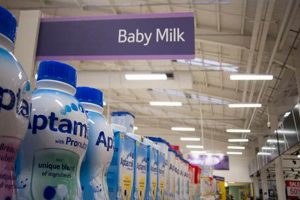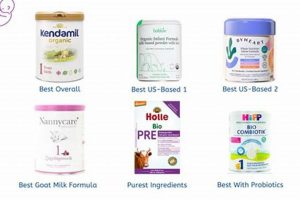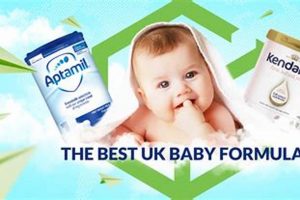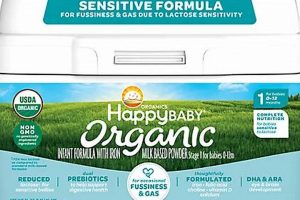The transportation of infant nourishment aboard commercial aircraft is governed by specific regulations established by transportation security agencies. These rules aim to balance passenger safety with the needs of individuals traveling with infants. Regulations generally permit passengers to carry a reasonable quantity of this nourishment through security checkpoints and onboard the aircraft, even if it exceeds the standard limitations for liquids. For instance, a parent traveling with a six-month-old child would typically be allowed to bring enough powdered or liquid nourishment to meet the child’s needs during the flight and potential delays.
Facilitating the travel of families with young children provides significant benefits. It ensures that infants have access to appropriate sustenance throughout their journey, mitigating potential health risks associated with inadequate or unavailable nourishment. Historically, inconsistent application of regulations created stress and inconvenience for traveling families. Standardized procedures, as they exist now, contribute to a smoother and more predictable travel experience, reducing anxiety for parents and caregivers. This consistency supports family travel, promoting tourism and economic activity related to family vacations and relocation.
Understanding the specific guidelines regarding the acceptable forms of infant nourishment, the screening process at security checkpoints, and the impact of international travel regulations is crucial. The following sections will delve into these aspects, providing clarity on navigating the transportation of such items on aircraft.
The following recommendations are designed to facilitate a smooth and efficient travel experience when transporting infant formula via air travel, adhering to security regulations and ensuring the infant’s nutritional needs are met.
Tip 1: Quantity Assessment: Estimate the required amount of infant formula based on the flight duration, potential delays, and layovers. It is advisable to pack a surplus to account for unforeseen circumstances.
Tip 2: Acceptable Forms: Familiarize oneself with the different forms of formula permitted by the Transportation Security Administration (TSA), including powdered, liquid (ready-to-feed), and concentrated forms. Each may be subject to varying screening procedures.
Tip 3: Packaging and Labeling: Ensure that all formula containers are clearly labeled. Original packaging is preferred. If transferring formula to smaller containers for convenience, label each container clearly with the contents.
Tip 4: Security Screening Awareness: Be prepared for additional screening of the formula at security checkpoints. This may include opening the containers for testing. Allow extra time to accommodate this process.
Tip 5: Notification to TSA Agents: Inform TSA agents at the beginning of the screening process that traveling with infant formula. This proactive communication can expedite the screening process and prevent misunderstandings.
Tip 6: Ice Packs and Cooling: When transporting liquid formula requiring refrigeration, utilize ice packs or gel packs to maintain a safe temperature. Ensure these cooling elements are also compliant with TSA liquid volume restrictions if they are not frozen solid.
Tip 7: International Travel Considerations: Research the regulations of the destination country regarding the importation of infant formula. Some countries may have restrictions or require specific documentation.
Adhering to these guidelines minimizes potential delays and ensures that the infant has access to necessary nourishment throughout the journey. Preparation and awareness are key to a successful travel experience.
The subsequent section will address frequently asked questions regarding air travel with infant nourishment, providing further clarification and addressing common concerns.
1. Acceptable quantities
The determination of “acceptable quantities” is a core component of the policy regarding bringing infant formula on an airplane. The permissibility of transporting infant nourishment hinges on the concept of reasonableness, aligning the amount carried with the infant’s anticipated needs during the flight and potential delays. Exceeding this reasonable threshold may raise security concerns, potentially leading to further inspection or limitations. For example, a family traveling on a direct two-hour flight would likely have different quantity requirements than a family undertaking a twelve-hour journey with multiple layovers.
Adherence to “acceptable quantities” not only facilitates smoother security screenings but also ensures adequate sustenance for the infant throughout the travel period. Overestimating needs mitigates risks associated with unexpected delays, while underestimating could lead to distress if the infant’s feeding schedule is disrupted. Practical application of this understanding involves calculating the average formula consumption per feeding, multiplying it by the anticipated number of feedings during the flight, and adding a buffer for unforeseen circumstances. A parent may also want to consider having a backup supply available at their destination to avoid any last minute issues.
In summary, the concept of “acceptable quantities” is a crucial determinant in whether infant formula can be carried on board an aircraft. This principle balances security considerations with the practical needs of traveling families. A thorough understanding of an infant’s consumption patterns, coupled with a margin for error, is essential for ensuring compliance and a stress-free travel experience.
2. Permitted forms
The correlation between acceptable types of infant formula and the ability to transport it on an airplane (“can you bring baby formula on a plane”) is direct and consequential. Regulations delineate specific types of infant nourishment that are typically permitted, including powdered, liquid (ready-to-feed), and concentrated variants. The permissibility of carrying infant formula through security checkpoints and onto aircraft is contingent upon adhering to these form-specific guidelines. For instance, while powdered formula is generally allowed, it may be subject to different screening procedures than its liquid counterpart. Similarly, discrepancies may arise in the acceptance of homemade versus commercially prepared formulas.
Understanding which forms are considered acceptable is paramount for effective travel planning. Failure to comply with these guidelines can result in confiscation of the formula or significant delays during security screening. Consider a scenario where a traveler attempts to carry a form of infant formula not explicitly approved by the TSA; this may lead to extensive questioning, testing, or outright denial of boarding with the item. Conversely, knowledge of acceptable forms allows for proactive preparation, such as opting for pre-packaged, commercially available liquid formula that conforms to regulations. Knowledge facilitates smooth transit through airport security, ensuring that the infant’s nutritional needs are met throughout the journey.
In summary, the identification of “permitted forms” is an essential prerequisite for successfully bringing infant formula on a plane. Its importance lies in mitigating potential conflicts with security protocols and facilitating unimpeded access to necessary sustenance for the infant. Challenges related to interpreting form-specific rules can be addressed by consulting the TSA website for up-to-date guidance. Compliance with form regulations is integral to the broader aim of safe and stress-free air travel for families with infants.
3. Security screening
Security screening procedures directly influence the feasibility of transporting infant formula aboard aircraft. The screening process represents a critical control point where compliance with regulations is assessed. Failure to adhere to established protocols at this stage can result in delays, confiscation of the formula, or denial of boarding. The Transportation Security Administration (TSA) guidelines stipulate that infant formula is permitted, but it is subject to additional scrutiny. Agents may require opening containers for inspection, and liquid formulas may undergo testing for explosive materials. Therefore, the effective implementation of security protocols functions as a gateway, determining whether an individual may “bring baby formula on a plane.”
The practical implications of security screening are substantial for travelers with infants. For example, a parent traveling with pre-made liquid formula must anticipate the possibility of having each container opened and tested. This necessitates allowing extra time for the screening process. Conversely, opting for powdered formula may expedite the screening process, as it often undergoes less rigorous testing. Furthermore, clear communication with TSA agents regarding the presence of infant formula and a proactive approach to adhering to guidelines can minimize potential complications. Preparing for these security measures mitigates the risk of disruption and ensures the infant’s access to necessary nourishment during the flight.
In summary, security screening forms an integral link in the chain of events that determine whether infant formula can be transported on an airplane. Understanding the process, anticipating potential challenges, and adhering to guidelines are paramount. Successful navigation of security checkpoints not only enables travelers to bring necessary infant formula but also contributes to a more efficient and less stressful travel experience. Challenges may include inconsistent application of procedures or misunderstandings about regulations; however, preparedness and proactive communication serve as effective countermeasures.
4. International regulations
International regulations significantly influence the ability to transport infant formula on aircraft crossing national borders. While baseline allowances for carrying infant nourishment typically exist, specific import restrictions, labeling requirements, and prohibited substances vary considerably across different countries. Discrepancies in regulatory frameworks create a complex landscape for travelers. A substance deemed acceptable in one jurisdiction may be restricted or banned in another, directly impacting the permissibility of bringing infant formula on a plane destined for that location. For instance, certain countries may impose stricter limits on liquid volumes or require specific documentation verifying the formula’s origin and composition. Understanding these nuances is paramount for avoiding potential legal issues or the confiscation of essential supplies at the point of entry.
The practical implications of international regulations are far-reaching. A parent traveling with infant formula to a country with stringent import controls may face challenges if unaware of these regulations. The consequences can range from the inconvenience of having formula confiscated to the more severe implication of being unable to readily acquire suitable replacements at the destination. To mitigate these risks, comprehensive research into the destination country’s customs policies concerning infant formula is essential. This includes consulting official government websites, contacting embassies or consulates, and seeking advice from experienced travel advisors. Such proactive measures ensure compliance with international laws and safeguard the infant’s nutritional needs during the journey.
In summary, international regulations act as a crucial determinant in the permissibility of transporting infant formula on international flights. Variances in legal frameworks across nations necessitate careful planning and adherence to specific import guidelines. Failure to account for these regulations can lead to significant challenges and potential disruption of the infant’s nourishment. A proactive approach, involving thorough research and compliance with all applicable laws, is essential for ensuring a smooth and problem-free travel experience.
5. Cooling methods
The maintenance of appropriate temperatures for infant formula during air travel constitutes a critical aspect of food safety and regulatory compliance. Proper preservation techniques directly impact the usability of infant formula, influencing the ability to transport and utilize it on an aircraft.
- Ice Packs and Gel Packs
Ice packs and gel packs represent common cooling agents used to maintain the temperature of refrigerated infant formula. Regulations require these items to be either frozen solid or compliant with liquid volume restrictions imposed by security agencies. Non-compliance may lead to confiscation. The use of such cooling methods enables the transport of perishable infant formula, ensuring its viability during the flight.
- Insulated Containers
Insulated containers, such as coolers or insulated bags, provide a thermal barrier, mitigating temperature fluctuations. These containers prolong the period during which infant formula remains within a safe temperature range. The effectiveness of insulated containers is contingent upon proper sealing and the initial temperature of the formula. Adequate insulation aids in compliance with health guidelines and ensures the availability of safe nourishment for infants during air travel.
- Dry Ice Regulations
Dry ice may be used as a more potent cooling agent; however, regulations governing its transportation are more stringent. Airlines often impose limitations on the quantity of dry ice permitted per passenger and mandate specific packaging requirements. Non-compliance with these regulations may result in the denial of transport. Proper adherence to dry ice regulations enables extended preservation of perishable infant formula, albeit with increased complexity and administrative burden.
- Temperature Monitoring
Employing a thermometer or temperature monitoring device can assist in verifying that infant formula remains within a safe temperature range. Regular temperature checks provide reassurance that the formula has not exceeded acceptable limits, thus preventing spoilage or bacterial growth. Active monitoring contributes to the safe utilization of transported infant formula and mitigates potential health risks.
The adoption of appropriate cooling methods is intrinsically linked to the capacity to successfully transport infant formula via air travel. The choice of cooling technique and adherence to associated regulations are crucial determinants in preserving formula integrity and ensuring compliance with transport security mandates. This, in turn, secures the availability of safe and usable infant sustenance for infants during air journeys.
Frequently Asked Questions
The subsequent section addresses common inquiries regarding the carriage of infant formula on commercial airlines. The aim is to provide clarity and guidance based on established regulations and best practices.
Question 1: What constitutes a “reasonable quantity” of infant formula permitted on a flight?
The assessment of “reasonable quantity” is predicated upon the duration of the flight, including potential delays, and the infant’s typical consumption patterns. Quantities exceeding demonstrable need may be subject to further scrutiny.
Question 2: Are there restrictions on the type of container used to transport infant formula?
While specific container types are not mandated, containers must be secure, leak-proof, and allow for efficient screening by security personnel. Original packaging is generally preferred.
Question 3: How does the Transportation Security Administration (TSA) screen infant formula at security checkpoints?
TSA agents may employ various methods, including visual inspection, opening containers, and utilizing specialized equipment to detect prohibited substances. Cooperation with TSA personnel is expected.
Question 4: Are there differences in regulations for domestic versus international flights concerning infant formula?
International flights are subject to the regulations of both the departing and arriving countries. Import restrictions and labeling requirements may differ significantly, necessitating prior research.
Question 5: What steps should be taken if refrigeration is required for liquid infant formula?
Ice packs or gel packs should be used to maintain a safe temperature. These cooling agents must comply with TSA liquid volume restrictions if not frozen solid.
Question 6: What documentation, if any, is required to verify the necessity of carrying infant formula?
While specific documentation is not typically required, possessing a medical note from a pediatrician may expedite the screening process in cases of specialized dietary needs.
Adherence to these guidelines promotes a smoother and more predictable travel experience. Proactive planning and awareness of regulatory requirements are essential.
The subsequent discussion will delve into advanced strategies for managing infant nutrition during extended travel, addressing topics such as sourcing formula at the destination and navigating unfamiliar food safety standards.
Conclusion
The preceding discussion has explored the complexities surrounding “can you bring baby formula on a plane”. Key aspects examined included acceptable quantities, permitted forms, security screening procedures, international regulations, and appropriate cooling methods. Successfully navigating these variables requires diligent preparation and adherence to established guidelines. A thorough understanding of TSA protocols, destination-specific import laws, and best practices for maintaining formula integrity is crucial for ensuring a seamless and stress-free travel experience for families with infants.
Given the potential for variability in regulations and evolving security measures, continuous vigilance and proactive information gathering are essential. Prior to any air travel involving infant formula, travelers should consult official sources for the most current guidance. This commitment to informed decision-making not only facilitates compliance but also safeguards the well-being of the infant and promotes efficient travel. Only through diligent adherence to established protocols can individuals ensure the safe and lawful transport of essential infant nourishment, contributing to a more predictable and less stressful journey.







![Best European Baby Formula vs American Options? [Guide] Baby Care 101: Essential Tips for Happy, Healthy Babies Best European Baby Formula vs American Options? [Guide] | Baby Care 101: Essential Tips for Happy, Healthy Babies](https://singlebabies.com/wp-content/uploads/2025/12/th-787-300x200.jpg)